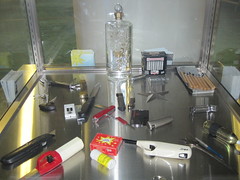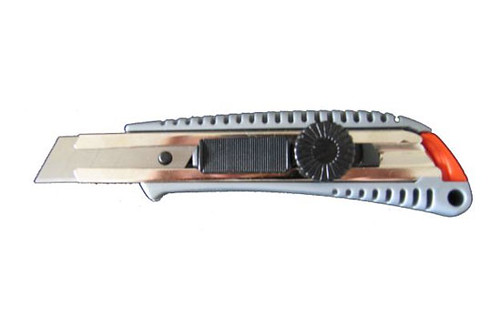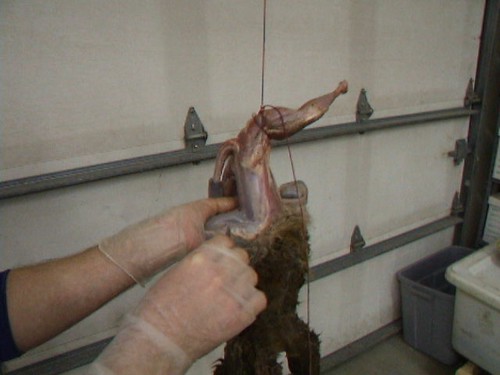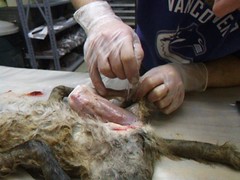In this article I will introduce my personal definition of play, but acknowledge that play is basically indefinable because it is so vast and variable. I examine free flow play and the obstacles to play, and the purpose and value of play. I examine one small group of students working definition of play as a developmental tool that helps children develop holistically and other aspects of our definition, ie a developmental journey, play being accessible to all, and the aspect of fun and enjoyment in play. Alongside this, this article examines structured and unstructured play, including theorists views and I include some of my own observations and examine the play content in them.
Box Cutter
Before I extend on group's definition of play, I would like to state my own theory about play, and explain what I mean stressing again, that play is basically indefinable because of its flexible and vast nature.
Box Cutter
My theory is that play is fluid. It can take many forms, have many meanings, express itself in many ways, but it cannot be contained in a box or shape and labelled as 'play'. If play is taken out of one context and into another it changes its shape and purpose, and the way it moves and performs. All of it is play in its many facets, and all of it is of equal value, because it meets the differing needs of the child at the time it is being played.
Play is fluid so therefore cannot be defined purely as one aspect or another, and as water is fluid, so is play - it changes its shape to its environment, circumstances and players, taking on different forms, expressions and meanings to the players concerned. It has intrinsic meaning to the children and may change direction at any moment, according to the children's needs and personality etc. Bruce verifies that play is like fluid and free-flowing,
She stated: "the whole point about play is that it cannot be pinned down. It flows. It is on the move." (Bruce 2004:154)
Free-flowing play can be limited by obstacles such as time, adults, relationships, routines, outcomes, interferences, circumstances, environment, or disability, and may not flow in the natural direction a child may wish to take it if limited by any of the above obstacles. However, because play is fluid, it can continue where it was left, or be restarted and flow in entirely different direction if obstacles do not restrict play.
Props may be used during free flow play which then takes on a symbolic characteristic, and children may engage in role play or socio-dramatic, plus rough and tumble, all rolled up into one, making it difficult to untangle and define! Children do not need adults to direct free-flow or fluid play, only to keep them safe from harming themselves or harming others. This may be viewed as an obstacle by children (and so it is) but as long as adults are not being 'over-protective' or 'over-restrictive' and children understand the need for safety rules (they tend to like rules in play anyway!) then the
obstacle or interruption is only a temporary obstacle, that children can overcome and move one, because their play is flexible and fluid.
The purpose or value of play, as mentioned is intrinsic to the child and players and appears to be part of children's developmental journey. Bruce (2004:149) describes play as a process with no productive end. Play helps children develop in a holistic way, developing their social interactions, language skills, co-operation, understanding of how the world works, and personal, social and emotional development. Play is a tool that brings knowledge and experiences together. Vygotsky viewed play as a vehicle (or tool) for social interaction. Bruner believed roleplay was a vehicle (or tool) for learning about society's rules and conventions. Piaget believed play unifies children's experiences, knowledge and experience. Frobel, Steiner, and Issacs were the biggest advocates of holistic development. Frobel believed learning and development is holistic, involving the child, other adults and the environment, and that childhood is a stage in it's own right. Steiner based his principles on Frobels and developed a programme involving
play. Issacs believed play was central to the overall development of the child.
Play is as an important of children's developmental journey - it becomes a tool by which children learn to develop in a holistic manner, it enables them to understand themselves, other people, their community and the world around them. Play also enables children to act out experiences, past and present, and enter into fantasy worlds. Bruner believed that play is process-led rather than task orientated, but also believed it prepares children for adulthood. (Fisher 1996:97) We are all on a lifelong journey and the journey, and the journey for me may be different to your journey. We may start at the same place, but go in different directions, and we may meet again but be different people, because life (and play, as part of that process) shapes the people and character we become. The journey of developing and learning is a long, slow, and ongoing process throughout life - a developmental journey which starts at birth and finishes at death, and play in its many fluid forms, becomes part of the process.
If play is structured, directed or initiated by adults, play takes on a different role. If play has a goal, target or outcome for a child to achieve, often children do not view this type of play as play, but as work.... they view
work as teacher-directed and play as choice, sitting down as working, and being active as playing (Wood & Attfield, 2005:17). However, a divide between play and work cannot easily be made. Children learn in and through play, whether it is teacher initiated or child initiated. Frobel, Steiner, Issacs, Piaget believed play should not be directed. Miss Boyce believed in a mixed approach, including free flow play and a more structured timetable for teacher-directed sessions. Montessori, demonstrated skills to children and did not believe in freeplay. Brunner saw play as a process but also believed adults need to scaffold children's experiences in order to help them progress to the next stage, as did Vygotsky, who advocated adults working alongside children to build on / scaffold their understanding to move them onto the next stage. McMillian also believed in a structured environment that was planned to support children's needs, and which integrated subjects such as maths, science and literacy.
Whether play is adult led or child led, children will learn many skills through play such as; co-operation, negotiation, other people's views, social skills, language skills, fine and gross motor skills may improve and other skills may
be mastered, thinking and cognitive skills are used and improved, so therefore children will learn through play whether there is an intended outcome or not! My own observations of children's play confirmed this. Children learned through many different types of play, structured and unstructured. Structured play helped children develop more in the cognitive realm whereas unstructured play helped children develop more in the creative, language, physical and personal/social realm.
If they do meet the outcomes (which they should do if the resources, processes and intensions are aimed at the right level...) then this is an added bonus! If planned and resourced correctly by practitioners, play can help children meet targets within the Foundation Stage or Key stage 1, covering all aspects of the curriculum from Personal, social and emotional development through to creative development.
Adults can improve the quality of children's play by providing a rich variety of resources, and well planned structured play, indoors and out, needs sensitive scaffolding for children to progress or learn new skills and knowledge. Adults also need to provide plenty of free flow play, and time
to complete tasks. If adults aim to intervene as little as possible in free play, this will provide a better outcome for children.
In structured play the teacher/adult has used play as a 'tool' (others call it a vehicle or medium) but may not be viewed as play in its purest form. Play cannot be categorized into 'play' or 'not play' (because play is fluid and takes many forms) but may be better defined as 'more pure play' or 'less pure play'' (Wood & Attfield 2005:4-5) Wood and Attfield further define pure play as unstructured, active, fun, a process, pretend, child invented and child-choosen. Linden states, "Circumstances can prevent or restrict play. Constraints may be placed by adults or the environment limits children's experiences. Alternatively, developmental problems, disability or illness can shape the possibilities for children." Play may be hampered (children may have obstacles to play) if they have any form of disability or cultural, language, social or economic differences. Children (like adults) tend to be exclusive, uncertain about things or people they don't understand or are not like them, unless they are informed/educated that all children have an equal right to play and should be granted access and opportunities to play.
Children need adults to be good role models demonstrating equality by provision and adaptability to children's needs. Children need adults to provide different types of play or different ways of playing, so that children can access it. Some children may need more adult support to access play, especially if there is some form of disability or complex needs. These children may access play differently, but all children have the same right to develop in a holistic way that all children do. All children need the 'tool' of play for their own development; because play is fluid, the way the tool is used may be different.
I observed a young boy (of about 8 years old) and other children aged between 6-10 years in a social club setting. All the children, except the little boy of 8, were engaged in locomotive play. They were chasing, tickling, rolling, dancing etc throughout the night, mainly in small groups of children. The play looked chaotic but was not out of place in the setting. The adults observed this play and did not intervene. The children appeared
to have no purpose or intension but to enjoy themselves, and the value to them was in participating in the fun, making up games and dances, enjoying social activities together and passing time in an enjoyable way.
The other little boy of 8 however, did not join in any of the play, he merely acknowledged the other children. Instead of playing with the other children, this little boy stood in front of the band that was performing, and appeared to be conducting them (using a toy), virtually all night. He was engrossed in his play/work. Later on when the band had a break, he circled around the
hall floor, (walking on his toes) making 'car-like' movements. At this point the boy may have been involved in role play. However, his first play was very difficult to understand (possibly role play or practice play?) This little boy appeared to have special needs along the line of Asperger's syndrome (noted from previous study and personal experience) I suspected Asperger's syndrome because he did not communicate with the other children, contact them, play alongside them, or join in their play. When they came near him once during locomotive play, he visible repelled / moved himself clearly out of their way. He couldn't or didn't access any type of social, co-operative or
parallel play, but preferred his own solitary activity and the type of play he engaged in was repetitive. Although his play didn't make sense to me, it was meaningful to him. He appeared to believe he was truly directing the band (though they ignored him and continued their performance) however he was engrossed in roleplay or practice play and appeared to enjoy what he was doing. His play was intrinsically valuable to him and he had as much right to play in this way as the other children had to play in their way. Linden Stated "Play stems from children's own perception of the world and how it works... play is a very personal, creative activity... within children's understanding, their play is meaningful in it connection to non-play reality. (2000:43).
I also observed other types of play in other settings with younger children. The type of play I observed included socio-dramatic (2-3 year olds involved in playing with dolls, prams and accessories, going shopping etc); exploratory play (2-3 year olds exploring playdough and cutters, moulding, shaping, cutting etc); creative play - free painting, mixing paints, making patterns and pictures and epistemic play (2-6 year olds involved in table top games,
including sounds game, snakes & ladders and alphabet jigsaw). The learning processes during these observations was vast, from social skills, co-operation and concentration to language skills, physical skills, fine motor skills, mathematic skills, creative skills to cognitive skills, being used, extended and enhanced in play to the benefit of the child/ren concerned.
Play however, is not just a tool that enables development, play in itself is fun and has value in itself. Play is as valuable to the child as work is to adults. Fisher (96:103) stated "Play has its own intrinsic rewards, it is done spontaneously and voluntary and it is thoroughly enjoyable." If play is self-chosen, self-motivated and directed, then it can only be enjoyable. Theorists such as Lazarus and Garvey hold this view; indeed children would not engage in play so readily if it were not so! Linden (2001:44) stated, "children play for play's sake. The activity is an end in itself and is not undertaken for an end product."
Conclusion
In this article I have stated my theory of play as being fluid, and other aspects or definitions of play and its value in children's development. Included in this are some theorist's views of play, and observations of children's play and what they are gaining from it, noting however, that defining play in all its elements, is very difficult! Play has many facets and functions it is impossible for one or two statements to adequately state what play is or does and many theorists hold differing views, reflecting this difficulty.
Play has become a tool in the Early Years sector and education and it is key to understanding how children think and feel. It has become clearer to me that play is crucial to children's social and emotional development, and other aspects such as language skills, cognitive skills and understanding the world in which they live. It has also become clearer to me that the least amount of time adults intervene in children's play, the better! (Though of course there is a time when structured play is appropriate). Play is enjoyable and motivating and a tool that develops children holistically and plays is fluid in that it fulfils many different roles that aids children in their developmental journey.
http://childsworld.info
How Does Play Help Children's Development?
Box Cutter
Dec 16, 2011 21:41:29

Click for larger image and other views
 >> Click here to update Christmas prices for Japanese Pan Pita - Uncrustable Sandwich Press Maker <<
>> Click here to update Christmas prices for Japanese Pan Pita - Uncrustable Sandwich Press Maker <<
Christmas Sales Japanese Pan Pita - Uncrustable Sandwich Press Maker Feature
- Japanese Pan Pita - Uncrustable Sandwich Press Maker
Christmas Sales Japanese Pan Pita - Uncrustable Sandwich Press Maker Overview
Plastic Sandwich Maker Dimensions: 6-1/8 x 8-5/8 x 1-3/8in HFinished Dimension: 4.4 x 4.4 x 1.25 inches Made in Japan
SAVE NOW on Christmas Sales Offers below!
Available In Stock. |
| This Christmas Japanese Pan Pita - Uncrustable Sandwich Press Maker ships for FREE with Super Saver Shipping. |
|

Limited Offer Today!! Japanese Pan Pita - Uncrustable Sandwich Press Maker Christmas and Cyber Monday 2011 Deals
Portable Compressor












